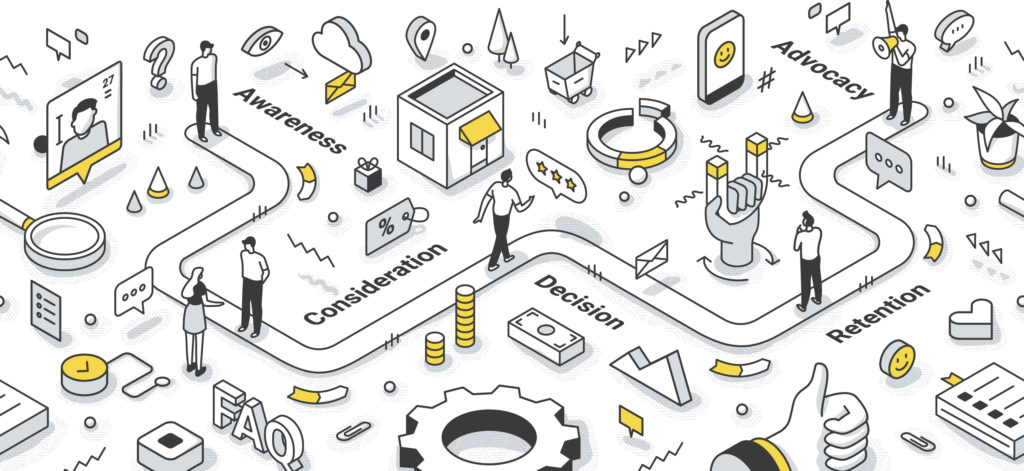In the dynamic realm of customer analytics, where organizations are flooded with data on consumer behavior, a new frontier emerges. The convergence of purchasing habits, media consumption, online interactions, and customer sentiment offers an unprecedented opportunity for brands to delve into the intricate tapestry of their customers.

Diving into this data reveals a multitude of descriptive insights, shaping a comprehensive understanding of customers. Queries like the proportion of those who seamlessly navigate both online and offline, the impact of your latest television campaign and its positive resonance, their browsing habits, and the sentiments expressed about your cutting-edge product feature – all provide a snapshot of your customer landscape.
Yet, mere descriptions alone fall short when it comes to guiding strategic decisions aimed at attracting and retaining customers. To unlock the true potential of customer analytics, a transformative approach is required – one that transcends description and ventures into the realm of strategic planning.
Consider this: while you may have statistics on the viewership of your brand’s latest television campaign, comprehending its return on investment requires a holistic synthesis of marketing, consumer behavior, and sales data. Such integration surpasses the boundaries of traditional descriptive customer analytics. Enter simulation, the catalyst that augments and elevates customer analytics to new heights.
Simulation empowers decision-makers by harnessing the vast array of data sets, enabling the discovery of invaluable insights. It transcends the limitations of static analysis, offering a dynamic perspective that molds customer data into a strategic blueprint for growth.
By simulating various scenarios and modeling customer behavior, organizations can navigate the intricate web of information to make informed, forward-thinking decisions.
With simulation at the helm, customer analytics becomes a vibrant playground of possibilities, where brands can unlock the secrets of their customers, shape their strategies, and foster enduring customer relationships.
Two examples of how simulation can be applied to answer more broad and strategic business questions include:
- Customer Loyalty: Uncover the secrets of customer loyalty through simulation, unraveling the factors that fuel unwavering devotion and boost retention.
- Cross-channel Effects: Dive into the impact of marketing channels on individuals, harnessing synergistic effects to craft irresistible strategies that lure in new customers.
Customer Loyalty
Customer analytics can provide a glimpse into the percentage of customers loyal to your brand, but it falls short of explaining the underlying reasons behind repeated purchases. The following section describes how simulation can be used to understand drivers of loyalty:
In the past decade, the availability of individual-level purchasing data has opened a world of analytical possibilities to delve into consumer behavior. By connecting insights on consumer behavior to aggregate sales outcomes, marketers can gain invaluable insights into both the short-term and long-term effects of their marketing efforts.
One crucial element influencing the long-term impact of marketing is the level of loyalty exhibited by consumers. How likely are consumers to consistently repurchase a particular brand, rather than exploring alternatives and switching between brands? Simply quantifying repurchases and switching percentages is insufficient to shape an effective marketing strategy.
To truly make a dent in the market and influence consumer behavior, it is essential to identify the factors that drive customers to repeatedly choose a specific brand. Whether the aim is to disrupt the market and encourage consumers to switch to your brand or to maintain loyalty amidst a dynamic marketplace, understanding the intricate drivers of loyalty is paramount.
Recognizing that “loyalty” encompasses a spectrum of consumer behaviors and mindsets, unrelated to mere affection for a brand, marks the first step. Simulation emerges as the key that unlocks these hidden dynamics, allowing marketers to decode the complexities of consumer loyalty and design strategies that elicit desired behaviors.
Below is a list of various factors that may drive repurchase behavior in a market:
1. Inertia – defaulting to a brand out of habit. Day-to-day consumers are faced with many decisions, but everyone has limited time and energy to apply cognitive effort to choose. So oftentimes, consumers take the decision-making shortcut of simply following a routine and taking the path they usually do.
2. Awareness – buying a brand due to the absence of alternatives in mind. In some cases, consumers may simply take a path because they do not know of any other way.
3. Pricing – choosing the lowest cost alternative. Many consumers are hunting for the best deal and may choose the most competitively priced option.
4. Perception – staying loyal to a brand that is held in high regard. Consumers may continue to buy a brand because they think it is the best of the alternatives available.
By harnessing the power of simulation, businesses can gain a competitive edge, transform their market presence, and navigate the ever-evolving consumer landscape with confidence and precision.
Consumer loyalty extends beyond sentimental attachments to a brand, as human nature often gravitates toward practical factors. Similar to how dog owners desire their pets to return home out of genuine love rather than laziness, convenience, or lack of alternatives, brand managers yearn for unwavering consumer devotion. However, hope alone is an insufficient strategy. To maximize the potential of customer analytics, managers must recognize that loyalty is shaped by a spectrum of ever-evolving factors within a dynamic market. Embracing this reality empowers businesses to thrive in a competitive environment.
Cross-channel Effects
While customer analytics provides insights into the marketing tactics individuals encounter and how their behavior aligns with them, it only scratches the surface of understanding how these strategies truly influence consumer behavior.
Enter simulation, a valuable tool that unravels the interplay of marketing channels and their cross-channel effects on various consumer properties.
Cross-channel effects materialize when the sum of individual marketing components surpasses their collective impact. These effects can take the form of positive synergies or negative inefficiencies, shaping the overall effectiveness of marketing efforts.
Consider a scenario where you have two potent media channels at your disposal: TV and Facebook. The question arises: should you deploy them separately or in conjunction? The answer hinges upon the cross-channel effects between these channels, specifically whether their combined utilization yields a distinct sales lift compared to running them individually and adding the resulting sales lift together. This intricate interplay defines the presence of cross-channel effects. Let’s explore the different types of cross-channel effects that may emerge:
- Positive Synergistic Effects: When running both TV and Facebook channels together generates a sales lift greater than the combined effects of running each channel separately. In this case, the whole becomes greater than the sum of its parts, amplifying the impact of your marketing campaign.
- Negative Inefficient Effects: Conversely, negative cross-channel effects occur when running both channels together yields a sales lift lower than what can be achieved by running each channel separately. This suggests a lack of compatibility or even counterproductive dynamics between the two channels, highlighting the need for optimization.
Simulation takes center stage in unraveling these cross-channel effects, allowing marketers to navigate the complex terrain of marketing strategies. By leveraging simulation, businesses can fine-tune their marketing mix, harness synergies, and optimize their outreach to captivate consumers with precision and finesse.
Synergistic Cross-Channel Effect

In this case, the sum of the parts is less than the two considered as a whole. There is some extra lift in sales that results from a synergistic interplay between both channels.
Inefficient Cross-Channel Effect

In this case, the sum of the parts is greater than the two channels working together, which has created some inefficiencies.
The cross-channel effect is therefore defined as the difference between the individual lifts and the total lift:
[Lift in Sales from TV] + [Lift in Sales from Facebook] + [Cross-Channel Effect] = [Lift in Sales from TV & Facebook].
Regression analysis is commonly employed to study the impact of marketing activities on sales, using sales as the dependent variable. Through regression, cross-channel interactions can be quantified by incorporating interaction terms in the model. This technique enables the measurement of media effects, sales attribution, and cross-channel interactions. However, understanding the underlying mechanism driving these effects may remain elusive.
To truly comprehend the driving force behind cross-channel interactions, we must acknowledge that the connection between marketing activity and sales resides within the realm of consumer decision-making. It is the consumer’s thought processes and behaviors that ultimately shape sales outcomes. This begs the question: How do consumers make their choices?
Unraveling this mystery requires a deep understanding of consumer decision-making. Exploring the cognitive and psychological factors that influence consumer choices is paramount. By grasping the intricacies of consumer decision-making, businesses can craft strategies that resonate with their target audience and drive impactful sales outcomes.
Consumer Decision-Making is the Key to Cross-Channel Effects
The growth of behavioral economics as a scientific discipline has revolutionized our understanding of consumer behavior. By incorporating heuristics and rationality, we can create simulated models that capture the complexities of decision-making. These models surpass the limitations of perfect equilibrium and neo-classical economics, which were not originally designed for this purpose.
In essence, consumers make choices by evaluating and selecting options based on their perceived attributes and importance (guided by utility maximization). This perspective unveils a clear path in the consumer decision-making process, where consumers consider options and prioritize attributes to arrive at their final choice.

In the quest for sales growth, both brand awareness and brand perceptions play vital roles. Different touchpoints excel at building either awareness or perceptions. Focusing solely on brand awareness while neglecting poor brand perceptions can be counterproductive, as increased media exposure may not resolve underlying dissatisfaction. Similarly, attempting to deepen engagement for an unrecognized brand may prove futile without first establishing brand awareness.
The nonlinear consumer decision-making path introduces complexities that give rise to synergies and inefficiencies in the awareness stages. Inefficiency occurs when awareness-building or perception-building activities persist despite already reaching maximum brand awareness or perceptions. Saturation of awareness reveals diminishing returns from additional marketing efforts. Conversely, synergies emerge when touchpoints that enhance awareness and shape perceptions work together, amplifying the impact of perception-building campaigns through increased brand awareness.
To optimize results, we must avoid concentrating excessively on a single stage of the consumer decision-making process, as it may lead to inefficiencies. By strategically balancing our efforts across different steps, we unlock synergistic opportunities that drive meaningful consumer engagement and fuel sales growth.
Check the mapping below for an illustration of TV and Facebook’s role in our example.

Gaining insights into the factors driving synergies and inefficiencies within a marketing plan can significantly enrich strategic decision-making and enhance customer analytics. By delving into the non-linear consumer decision-making process and identifying bottlenecks and saturation points, teams can explore innovative strategies that strike a balance between building brand awareness and shaping perceptions. Simulations can serve as a valuable tool for testing these hypothetical strategies, allowing the inclusion of interim metrics like brand awareness, brand perceptions, and word-of-mouth activity. With this approach, businesses can optimize their marketing efforts and drive better outcomes.
